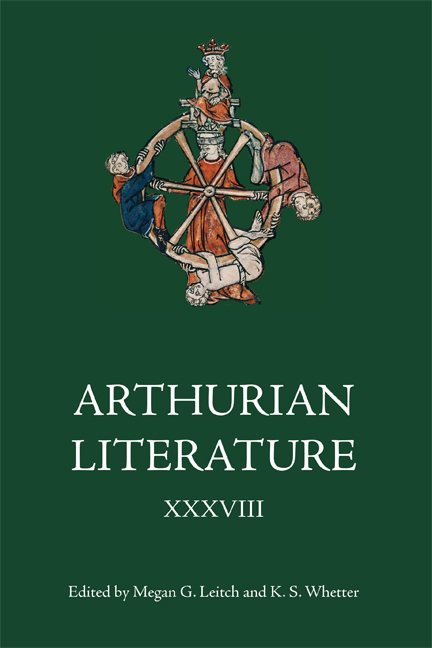Book contents
- Frontmatter
- Contents
- List of Figures and Tables
- Note on the Derek Brewer Prize
- General Editors’ Preface
- List of Contributors
- List of Abbreviations
- 1 The Inaugural Derek Brewer Essay Prize: Animals at the Feast: Strange Strangers and Courtly Power in The Wedding of Sir Gawain and Dame Ragnelle
- 2 The Kindred of a Boy without a Father: Merlin’s British Forebears and Irish Cousins
- 3 Geoffrey of Monmouth’s Subtle Subversion: Active Double- Voiced Discourse in the Historia regum Britanniae
- 4 ‘Cornwall, up in the North’: Geography and Place Names in the Source of the Old Icelandic Brut
- 5 Enacting Arthurianism in the Order of the Garter and Sir Gawain and the Green Knight
- 6 Deviants and Dissenters: Theorizing Shame and Punishment in Malory’s Morte
- 7 Loyalty and Worshyp in Conflict in Malory’s Lancelot
- 8 Emotional Inheritance in Malory’s Morte Darthur: Shame and the Lott–Pellinore Feud
- 9 Navigating and Indexing Arthurian Romance in Benoît Rigaud’s Edition of Lancelot du Lake (1591)
- 10 ‘A great many strange puppets’: Queen Caroline, Merlin’s Cave, and Symbolic Arthurianism in the Age of Reason
- 11 How Galahad Regained his Virginity: Dead Women, Catholicism and the Grail in Nineteenth-Century British Poetry
- Notes
- Miscellaneous Endmatter
5 - Enacting Arthurianism in the Order of the Garter and Sir Gawain and the Green Knight
Published online by Cambridge University Press: 10 January 2024
- Frontmatter
- Contents
- List of Figures and Tables
- Note on the Derek Brewer Prize
- General Editors’ Preface
- List of Contributors
- List of Abbreviations
- 1 The Inaugural Derek Brewer Essay Prize: Animals at the Feast: Strange Strangers and Courtly Power in The Wedding of Sir Gawain and Dame Ragnelle
- 2 The Kindred of a Boy without a Father: Merlin’s British Forebears and Irish Cousins
- 3 Geoffrey of Monmouth’s Subtle Subversion: Active Double- Voiced Discourse in the Historia regum Britanniae
- 4 ‘Cornwall, up in the North’: Geography and Place Names in the Source of the Old Icelandic Brut
- 5 Enacting Arthurianism in the Order of the Garter and Sir Gawain and the Green Knight
- 6 Deviants and Dissenters: Theorizing Shame and Punishment in Malory’s Morte
- 7 Loyalty and Worshyp in Conflict in Malory’s Lancelot
- 8 Emotional Inheritance in Malory’s Morte Darthur: Shame and the Lott–Pellinore Feud
- 9 Navigating and Indexing Arthurian Romance in Benoît Rigaud’s Edition of Lancelot du Lake (1591)
- 10 ‘A great many strange puppets’: Queen Caroline, Merlin’s Cave, and Symbolic Arthurianism in the Age of Reason
- 11 How Galahad Regained his Virginity: Dead Women, Catholicism and the Grail in Nineteenth-Century British Poetry
- Notes
- Miscellaneous Endmatter
Summary
The Order of the Garter was established by Edward III (r. 1327–77) in England in 1348, and continues to this day, a well-known example of the English nobility living out a performative idea of chivalry in the late medieval period and beyond. Here, I examine how the parallels between the Order and Arthurian romance texts were used by its medieval members to enact a chivalric fantasy of Arthurianism, which can be demonstrated by considering the material possessions of these knights. To illustrate these parallels, I draw on the remarkable links between the Order and the late fourteenth-century narrative poem Sir Gawain and the Green Knight. The material culture that links the two demonstrates how objects could encode the world of chivalric romance in historic cultural traditions. This in turn shows us something of the versatility of Arthurian romance in the fourteenth and fifteenth centuries, as a transitional mode of writing that was adapted to exist in between public and private or sacred and profane spaces.
I start with the hypothesis that Arthurian material culture, which we might describe as ‘Arthuriana’, was used to enact Arthurianism in medieval society, and that the Order of the Garter demonstrates how this worked in practice. ‘Arthurianism’ describes the literary and material culture concerned with Arthur and his court, and ‘material culture’ is broadly defined to encompass objects described in texts as well as physically created objects. As the growing body of Arthurian material culture scholarship shows us, there are benefits in reading medieval Arthurian literary sources as part of a wider cultural familiarity with these narratives. We must recognize that romance narratives do not exist in isolation, but instead formed part of the wider late-medieval cultural milieu.
The Garter Foundation Narrative
Edward III had considered founding his own Arthurian-inspired Order of the Round Table in 1344; his Arthurian interests may have been inspired by his earlier visit to the tomb of Arthur and Guenevere at Glastonbury Abbey in 1330. Although plans were made to build a hall to house this Order at Windsor Castle, the project was abandoned by the end of the year. The reasons for this abandonment are not certain from the surviving records, but it seems likely that the necessary finance had been used instead in the ongoing war against France, which we now know as the early stages of the Hundred Years’ War.
- Type
- Chapter
- Information
- Arthurian Literature XXXVIII , pp. 124 - 155Publisher: Boydell & BrewerPrint publication year: 2023



